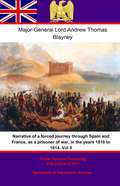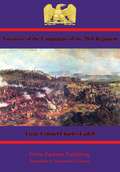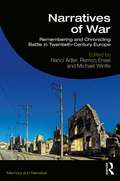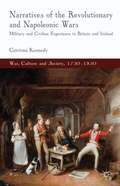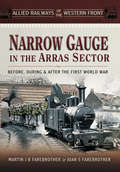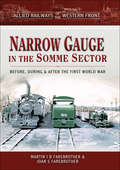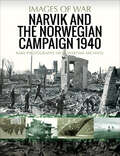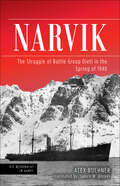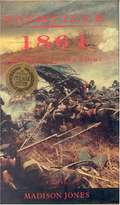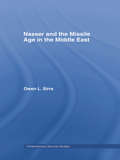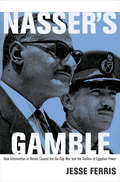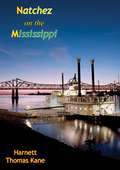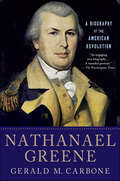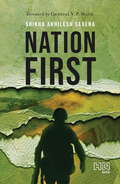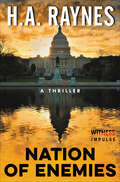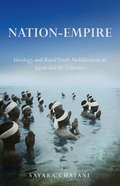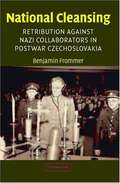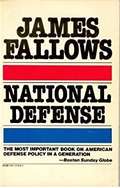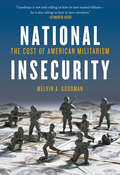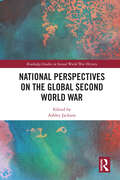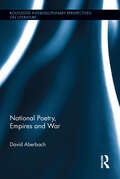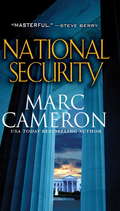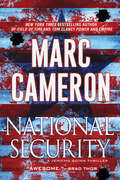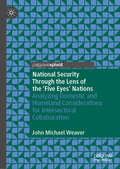- Table View
- List View
Narrative of a forced journey through Spain and France, as a prisoner of war, in the years 1810 to 1814. Vol. II (Narrative of a forced journey through Spain and France, as a prisoner of war, in the years 1810 to 1814. #2)
by Major-General Lord Andrew Thomas BlayneyThis ebook is purpose built and is proof-read and re-type set from the original to provide an outstanding experience of reflowing text for an ebook reader. Major-General Lord Andrew Thomas Blayney although previously a successful commander of his own regiment the 89th Regiment of Foot of the British through-out the early stages of the Peninsular war, he is best known for his narrative of events after his capture by Polish forces fighting under the flag of Napoleonic France. Blayney was the leader of an ill-fated Anglo-Spanish force which was assigned the task of attacking from Cadiz toward Malaga, culminating the battle of Fuengirola on 15th October 1810. Outnumbering his Polish foes by a huge margin, a series of unfortunate accidents on the allied side and brave and heroic resistance on the Polish side led to a debacle and his capture. It should be noted that this was far from the only amphibious disaster led by the British in the Peninsular Wars that should throw further perspective on the victories of the main British army under Wellington. Blayney's narrative along with some idiosyncratic spelling recounts his journey from Andulusia to Verdun in the north-east of France. During his journey from one outpost to another as a paroled prisoner he meets a number of famed French generals, as befitted his rank, such as Sébastiani, Kellermann, Belliard and even Marshal Bessiéres who treat him on the whole well. He winds his way through the countryside, and he tells many tales of the people and surroundings that he finds himself somewhat forcibly journeying through. The main strength of the narrative is the author's eye to detail and his flair for recounting a tale, along with the real rarity of accounts from the point of view of an English prisoner of war. Published in two volumes this is the second volume. Author - Major-General Lord Andrew Thomas Blayney, 11th Baron Blayney [30 November 1770 - 8 April 1834] Text taken, less appendices, from the 1814 edition, published in London by E Kerry Original - 519 pages. Linked TOC.
Narrative of the Campaigns of the 28th Regiment: Since Their Return From Egypt in 1802.
by Major Charles CadellThis ebook is purpose built and is proof-read and re-type set from the original to provide an outstanding experience of reflowing text for an ebook reader. The North Gloucestershire, or 28th Regiment of Foot, had a long and honourable list of successes during the Napoleonic Wars: they were engaged at Coruña, Talavera, Albuera, Vittoria, the Pyrenees, the Nive and the Nivelle, and were conspicuous during the Waterloo Campaign at both Quatre Bras and the era-defining battle. Captain Cadell (as he was at that time) served throughout the period, and his memoirs are filled with the hard engagements with the enemy. He commanded the company of grenadiers of the 1st battalion and was at the cutting edge of all the fighting. His writing style is lucid, filled with memorable anecdotes of the action, and often asides about the men under his command. An excellent memoir of a hard-fighting regimental officer. Title - Narrative of the Campaigns of the 28th Regiment Sub-Title - Since Their Return From Egypt in 1802. Author -- Major Charles Cadell (1786-1866) Text taken, whole and complete, from the edition published in 1835, London, by Whittaker & Co. Original - 281 pages. Illustrations - The map cannot be reproduced with this volume as it is A3
Narratives of War: Remembering and Chronicling Battle in Twentieth-Century Europe (Memory and Narrative)
by Nanci Adler Michael Wintle Remco EnselNarratives of War considers the way war and battle are remembered and narrated across space and time in Europe in the twentieth century. The book reflects on how narratives are generated and deployed, and on their function as coping mechanisms, means of survival, commemorative gestures, historical records and evidence. The contributions address such issues as the tension and discrepancy between memory and the official chronicling of war, the relationship between various individuals’ versions of war narratives and the ways in which events are brought together to serve varied functions for the narrators and their audiences. Drawing upon the two World Wars, the Spanish Civil War and the ex-Yugoslav wars, and considering narrative genres that include film, schoolbooks, novels, oral history, archives, official documents, personal testimony and memoirs, readers are introduced to a range of narrative forms and examples that highlight the complexity of narrative in relation to war. Approached from a multidisciplinary perspective, and taken together, analysis of these narratives contributes to our understanding of the causes, experience, dynamics and consequences of war, making it the ideal book for those interested in twentieth-century war history and the history of memory and narrative.
Narratives of the Revolutionary and Napoleonic Wars
by Catriona KennedyThe volume explores how the Revolutionary and Napoleonic wars were experienced, perceived and narrated by contemporaries in Britain and Ireland, drawing on an extensive range of personal testimonies by soldiers, sailors and civilians to shed new light on the social and cultural history of the period and the history of warfare more broadly.
Narrow Gauge in the Arras Sector: Before, During & After the First World War (Allied Railways of the Western Front)
by Joan S. Farebrother Martin J. FarebrotherThe Arras sector of the Western Front in World War I (WW1) was held partly by the British and Dominions 1st Army from September 1915, and almost wholly by the 1st and 3rd Armies from March 1916. No less than in the Ypres sector to the north and the Somme sector to the south, the struggles of the French and then British troops in this sector were pivotal to the outcome of the War. The sector included countryside in the south, but in the north a major part of the industrial and coal-mining area of northern France, around Lens and Bthune. In this book the contribution of metre and 60 cm gauge railways to the Allied war effort in this sector is examined in the context of the history of the metre gauge lines already established. The build up of light (60 cm gauge) lines from 1916 is examined in detail area by area, and the contribution of the related metre gauge lines is reassessed, from British and French sources. After the War the role of these railways in the reconstruction and recovery of this devastated region of France is described. Later the surviving part of the 60 cm gauge network served the sugar beet industry east of Arras. The history is followed through another World War to the closure of the last of these railways in 1957.The book refers to previous works on British War Department light railways in WW1, but contains sufficient general information for readers new to the subject. It also describes how to find key locations now, and how and where rolling stock can be seen. Six walks and an urban tour are included for those who wish to explore the territory in greater depth.
Narrow Gauge in the Somme Sector: Before, During & After the First World War (Allied Railways of the Western Front)
by Joan S. Farebrother Martin J. FarebrotherThe Somme sector of the Western Front was held by French forces until early 1916, when the British and Dominions Third and Fourth Armies moved into the northern part, before the joint First Battle of the Somme from July to November 1916. In 1917, with the German withdrawal to the Hindenburg Line, British responsibility moved further south. By early 1918 the British Third and Fifth Armies were responsible as far south as east of Noyon. In Spring 1918 the German attack and advance from the Hindenburg Line came west almost to Amiens. However the British and French Armies finally stopped the advance, and from August 1918 drove the German Army back eastwards until the Armistice on 11 November 1918.In this book the meter gauge networks established before the First World War are examined. Then the build up of light (60cm gauge) railways, initially mainly French but later British, in 1915 and 1916, is considered, with an assessment of the contribution of these and the meter gauge lines to the war effort. With the major movements of the front line in this sector in 1917 and 1918, the response of the narrow gauge railways is considered chronologically as well as by area, in the context of overall railway policy and development. After the war the light railways contributed to the reconstruction of the devastated areas, and then in some places served the sugar beet industry. The meter gauge railways were rebuilt or repaired. The story is followed to the closure of the last of these railways in the 1960s.This book is a companion volume to Narrow Gauge in the Arras Sector (Pen & Sword Transport, 2015) by the same authors. It refers also to other previous works on British and French railways in the First World War, but contains sufficient information to stand alone. It describes how to find key locations now, and where rolling stock can be seen. Some walks are included for those who wish to explore the territory.
Narvik and the Norwegian Campaign 1940 (Images of War)
by Philip JowettThe Norwegian campaign, fought in 1940, early in the Second World War in Europe, is overshadowed by the campaign in Poland that preceded it and the German blitzkrieg in the Low Countries and France that followed, yet it was a close contest from the military point of view and it had a far-reaching impact on the rest of the war. Philip Jowett’s photographic history is a vivid introduction to it. In a concise text and a selection of over 150 photographs he traces the entire course of the fighting in Norway on land, at sea and in the air. He describes how important it was for the Allies – the Norwegians, British and French – to defend northern Norway against the Germans, in particular to retain control of the strategic port of Narvik. The book documents in fascinating detail the troops involved, the aircraft and the large naval forces, and gives an insight into the main episodes in the conflict including the struggle for Narvik and the major clashes at sea which culminated in the loss of the Royal Navy’s aircraft carrier Glorious. The photographs are especially valuable in that they show the harsh conditions in which the fighting took place and offer us a direct impression of the experience of the men who were there.
Narvik: The Struggle of Battle Group Dietl in the Spring of 1940 (Die Wehrmacht im Kampf)
by Alex Buchner“An intensely detailed historical account and counterfactual analysis of the strategic dilemmas faced by German and Allied forces at Narvik.” —Naval Historical FoundationPublished for the first time in English, this is a German account of the German invasion of Norway in the spring of 1940. It focuses on the efforts of Group “1” led by Eduard Dietl. This group of Gebirgstruppen—mountain troops—was landed at Narvik in early April by ten destroyers. These ships were then all sunk by the Allies. Dietl’s troops were outnumbered by Allied troops but his defense utilized ammunition, food and sailors from the sunken ships and his men retook Narvik once the Allies abandoned their efforts to push the Germans out of Norway.“The book does provide detailed accounts of the numerous battles and skirmishes around Narvik in the spring of 1940. The maps are useful to help understand the terrain and geography. The focus of the text is at the tactical level, and any historian interested in the tactics of the Norwegian campaign or of German mountain troops at this time would find this especially useful.” —Journal of Military History“The story of Dietl’s improvisation in the face of such inadequacies is quite impressive . . . the best account in English of the German side of Narvik.” —Stone & Stone Second World War Books“A fascinating look at the battle from the German side. While the book does reflect the attitudes of the time it was written, it also reveals what the German troops faced and provides a good account of the various engagements in and around Narvik.” —WWII History Magazine
Nashville 1864
by Madison JonesA novel about the Civil War and the occupation of the Union Army in Nashville.
Nasser and the Missile Age in the Middle East (Contemporary Security Studies)
by Owen L. SirrsEgyptian efforts to acquire long-range surface-to-surface missiles in the early 1960s carry important lessons for our time, when weapons of mass destruction and charges of politicizing intelligence are key issues. This new study traces the history of the early Egyptian ballistic missile program, which began with the successful recruitment of German scientists who had experience in Hitler’s V1 and V2 missile projects. Yet even as these Germans began their work on developing missiles for Egyptian President Gamal Abdel Nasser, Israeli intelligence was busy collecting information on their activities, sparking a crisis in the Israeli leadership as top Israeli officials anxiously debated strategies to grapple with this new threat to their national security. Ultimately, they adopted a multifaceted approach that included intimidation of the scientists and their families, appeals to the West German government to order the scientists’ recall and an attempt to involve the US government in the intricacies of the Arab-Israeli conflict. Drawing extensively on material from recently declassified US government documents, this new major work demonstrates how Nasser’s missile program played an instrumental role in cementing the US-Israeli national security relationship. The book concludes with several key lessons that can help stem the global proliferation of advanced weapons. This book will be of great interest to scholars of proliferation, international relations, the Middle East, disarmament and security studies in general.
Nasser's Gamble: How Intervention in Yemen Caused the Six-Day War and the Decline of Egyptian Power
by Jesse FerrisNasser's Gamble draws on declassified documents from six countries and original material in Arabic, German, Hebrew, and Russian to present a new understanding of Egypt's disastrous five-year intervention in Yemen, which Egyptian president Gamal Abdel Nasser later referred to as "my Vietnam." Jesse Ferris argues that Nasser's attempt to export the Egyptian revolution to Yemen played a decisive role in destabilizing Egypt's relations with the Cold War powers, tarnishing its image in the Arab world, ruining its economy, and driving its rulers to instigate the fatal series of missteps that led to war with Israel in 1967. Viewing the Six Day War as an unintended consequence of the Saudi-Egyptian struggle over Yemen, Ferris demonstrates that the most important Cold War conflict in the Middle East was not the clash between Israel and its neighbors. It was the inter-Arab struggle between monarchies and republics over power and legitimacy. Egypt's defeat in the "Arab Cold War" set the stage for the rise of Saudi Arabia and political Islam. Bold and provocative, Nasser's Gamble brings to life a critical phase in the modern history of the Middle East. Its compelling analysis of Egypt's fall from power in the 1960s offers new insights into the decline of Arab nationalism, exposing the deep historical roots of the Arab Spring of 2011.
Natchez on the Mississippi
by Harnett Thomas KaneOriginally published in 1947, this book by New Orleans native Harnett Kane provides over 300 pages of detailed history of the Natchez area in Mississippi. It includes vivid descriptions of over 20 antebellum mansions, the personal stories of the families that built them, and the individuals who called them home. History buffs will be interested in reading about the many famous figures named in this book, such as Andrew Jackson and Aaron Burr, who were among those who helped shape the state's history, and in some cases, the history of the American nation.Also included in Kane's retelling of interesting and entertaining stories about Natchez are two that garnered national interest in years past: the famous steamboat race between The Natchez and The Robert E. Lee, and the infamous story of Natchez's "Goat Castle."A fascinating read.
Nathanael Greene: A Biography of the American Revolution
by Gerald M. CarboneThe intriguing life story of an unsung hero of the American Revolution from award-winning author Gerald M. Carbone. When the Revolutionary War began, Nathanael Greene was a private in the militia, the lowest rank possible, yet he emerged from the war with a reputation as George Washington's most gifted and dependable officer--celebrated as one of three most important generals. Upon taking command of America's Southern Army in 1780, Nathanael Greene was handed troops that consisted of 1,500 starving, nearly naked men. Gerald Carbone explains how within a year, the small worn-out army ran the British troops out of Georgia, South Carolina, and North Carolina and into the final trap at Yorktown. Despite his huge military successes and tactical genius Greene's story has a dark side. Gerald Carbone drew on 25 years of reporting and researching experience to create his chronicle of Greene's unlikely rise to success and his fall into debt and anonymity.
Nation First
by Shikha Akhilesh SaxenaTwo decades after India's resounding victory at Kargil, stories and accounts of the war continue to be narrated with immense pride. Yet, one pertinent perspective has been largely overlooked - that of the army wives. In this remarkable book, Shikha Akhilesh Saxena, wife of artillery officer Captain Akhilesh Saxena, describes the turmoil endured by the families of military officers in the face of conflict.As a young couple, Shikha and Akhilesh unexpectedly found themselves in the midst of war. Shikha deftly depicts her own experiences as well as those of Akhilesh, who took part in missions at Tololing, the Hump and Three Pimples. What does a soldier go through, when marching off to a near-suicidal mission? And what does it take to survive, even thrive, having sustained serious injuries in battle? This detailed memoir shows the boundless bravery of the Indian troops, as well as the emotional tumult experienced by their families both during and after the war. Nation First is a story of grit, determination and heroic patriotism shown by the men and women who give their all to safeguard the country.
Nation of Enemies: A Thriller
by H.A. RaynesA chilling, suspenseful new thriller in the vein of Michael Crichton and James RollinsIt's all about the genetics. DNA. Black & white.A decade ago the US government mandated that all citizens be issued biochips containing all of their medical information and an id number indicating a person's health. Then they made the information public—the implications of which were wide-spread and devastating.Now on the eve of the 2032 presidential election, the country is deeply divided and on the brink of civil war. But as the two major political parties face off, innocent Americans are dying at the hands of masked terrorists. When the Liberty Party's presidential nominee is assassinated in a highly-coordinated, masterful attack, it sets off a chain of events that will change the course of history and leave America's inalienable rights—life, liberty, and the pursuit of happiness—dangling on the precipice of extinction.
Nation-Empire: Ideology and Rural Youth Mobilization in Japan and Its Colonies (Studies of the Weatherhead East Asian Institute, Columbia University)
by Sayaka ChataniBy the end of World War II, hundreds of thousands of young men in the Japanese colonies, in particular Taiwan and Korea, had expressed their loyalty to the empire by volunteering to join the army. Why and how did so many colonial youth become passionate supporters of Japanese imperial nationalism? And what happened to these youth after the war? Nation-Empire investigates these questions by examining the long-term mobilization of youth in the rural peripheries of Japan, Taiwan, and Korea. Personal stories and village histories vividly show youth’s ambitions, emotions, and identities generated in the shifting conditions in each locality. At the same time, Sayaka Chatani unveils an intense ideological mobilization built from diverse contexts—the global rise of youth and agrarian ideals, Japan’s strong drive for assimilation and nationalization, and the complex emotions of younger generations in various remote villages.Nation-Empire engages with multiple historical debates. Chatani considers metropole-colony linkages, revealing the core characteristics of the Japanese Empire; discusses youth mobilization, analyzing the Japanese seinendan (village youth associations) as equivalent to the Boy Scouts or the Hitler Youth; and examines society and individual subjectivities under totalitarian rule. Her book highlights the shifting state-society transactions of the twentieth-century world through the lens of the Japanese Empire, inviting readers to contend with a new approach to, and a bold vision of, empire study.
National Cleansing: Retribution Against Nazi Collaborators in Postwar Czechoslovakia
by Benjamin FrommerNational Cleansing examines the prosecution of over one hundred thousand suspected war criminals and collaborators by Czech courts and tribunals after the Second World War. As the first comprehensive history of postwar Czech retribution, this 2005 book provides a new perspective on Czechoslovakia's transition from Nazi occupation to Stalinist rule in the turbulent decade from the Munich Pact of September 1938 to the Communist coup d'tat of February 1948. Based on archival sources that remained inaccessible during the Cold War, National Cleansing demonstrates the central role of retribution in the postwar power struggle and the contemporary expulsion of the Sudeten Germans. In contrast to general histories of postwar Czechoslovakia, which portray retribution as little more than Communist-inspired political justice, this book illustrates that the prosecution of collaborators and war criminals represented a genuine, if flawed, attempt to confront the crimes of the past, including those committed by the Czechs themselves.
National Defense
by James FallowsTHIS BOOK is designed to give the general reader better ways of thinking about defense. In the first few years of the 1980s, the United States will have to make choices of enormous consequence about the size, purpose, and composition of its military force. These include whether to restore the draft, build new nuclear missiles and bombers, enlarge the Navy, equip a "rapid deployment force" for intervention overseas.<P><P> Winner of the National Book Award
National Insecurity
by Melvin A. Goodman"Mel Goodman has spent the last few decades telling us what's gone wrong with American intelligence and the American military, and now, in National Insecurity, he tells us what we must do to change the way the system works, and how to fix it. Goodman is not only telling us how to save wasted billions--he is also telling us how to save ourselves." -- Seymour M. Hersh, The New YorkerUpon leaving the White House in 1961, President Eisenhower famously warned Americans about the dangers of a "military industrial complex," and was clearly worried about the destabilizing effects of a national economy based on outsized investments in military spending. As more and more Americans fall into poverty and the global economy spirals downward, the United States is spending more on the military than ever before. What are the consequences and what can be done?Melvin Goodman, a twenty-four-year veteran of the CIA, brings peerless authority to his argument that US military spending is indeed making Americans poorer and less secure while undermining our political standing in the world. Drawing from his firsthand experience with war planners and intelligence strategists, Goodman offers an insider's critique of the US military economy from President's Eisenhower's farewell warning to Barack Obama's expansion of the military's power. He outlines a much needed vision for how to alter our military policy, practices, and spending in order to better position the United States globally and enhance prosperity and security at home.Melvin A. Goodman is the Director of the National Security Project at the Center for International Policy. A former professor of international security at the National War College and an intelligence adviser to strategic disarmament talks in the 1970s, he is the author of several books, including the critically acclaimed The Failure of Intelligence.
National Intelligence Systems
by Gregory F. Treverton Wilhelm AgrellA series of investigations, especially in the United States and Britain, have focused attention on the performance of national intelligence services. At the same time, the onset of an era of terrorism and a broad span of trans-national security challenges has highlighted the crucial role of intelligence. This book takes stock of the underlying intellectual sub-structure of intelligence. For intelligence as for other areas of policy, serious intellectual inquiry is the basis for improving the performance of real-world institutions. The volume explores intelligence from an intellectual perspective, not an organizational one. Instead the aim of the book is to identity themes that run through these applications, such as the lack of comprehensive theories, the unclear relations between providers and users of intelligence, and the predominance of bureaucratic organizations driven by collection. A key element is the development, or rather non-development, of intelligence toward an established set of methods and standards and, above all, an ongoing scientific discourse. Here, in the transformation from an experience-based proto-science to a science of intelligence in-being, the book argues, lies perhaps the most fundamental challenge for a field of immense impact on the international community, on nations, and on individuals.
National Perspectives on the Global Second World War (Routledge Studies in Second World War History)
by Ashley JacksonThis collection of essays, written by authors of different nationalities, explores the experiences of the countries that were not numbered among the Second World War’s major belligerents, including colonies, 'lesser' powers, and neutral nation states. The story of the war is often dominated by the experiences, actions, and historical narratives of the major belligerent powers. By focusing on the war history of ten diverse countries, this analysis of the conflict’s global manifestations facilitates greater empathy with the experience of polities and societies dragged into regional and international conflicts. The volume offers valuable insights on the war’s place in national culture and collective memory. National Perspectives on the Global Second World War is an essential contribution to the study of the Second World War and will be of particular interest to scholars of imperial and colonial history, military history, and global history.
National Poetry, Empires and War (Routledge Interdisciplinary Perspectives on Literature)
by David AberbachNationalism has given the world a genre of poetry bright with ideals of justice, freedom and the brotherhood of man, but also, at times, burning with humiliation and grievance, hatred and lust for revenge, driving human kind, as the Austrian poet Grillparzer put it, ‘From humanity via nationality to bestiality’. National Poetry, Empires and War considers national poetry, and its glorification of war, from ancient to modern times, in a series of historical, social and political perspectives. Starting with the Hebrew Bible and Homer and moving through the Crusades and examples of subsequent empires, this book has much on pre-modern national poetry but focuses chiefly on post-1789 poetry which emerged from the weakening and collapse of empires, as the idealistic liberalism of nationalism in the age of Byron, Whitman, D’Annunzio, Yeats, Bialik, and Kipling was replaced by darker purposes culminating in World War I and the rise of fascism. Many national poets are the subject of countless critical and biographical studies, but this book aims to give a panoramic view of national poetry as a whole. It will be of great interest to any scholars of nationalism, Jewish Studies, history, comparative literature, and general cultural studies.
National Security
by Marc Cameron"Fascinating characters with action off-the-charts. Masterful. . .an entertaining romp." --Steve BerryWhen Terrorism Goes Viral, One Man Goes Ballistic.They can strike anytime, anywhere. A public landmark. A suburban shopping mall. And now, the human body itself. Three Middle Eastern terrorists have been injected with a biological weapon, human time bombs unleashed on American soil. They are prepared to die. To spread their disease. To annihilate millions. If America hopes to fight this enemy from within, we need a new kind of weapon. Meet Special Agent Jericho Quinn. Air Force veteran. Champion boxer. Trained assassin. Hand-picked for a new global task force that, officially, does not exist, Quinn answers only to the Director of National Intelligence and the U.S. President himself. His methods are as simple, and as brutal, as his codename. The Hammer."One of the hottest new authors in the thriller genre. . .terrifying. . .in one word: Awesome." --Brad ThorA native of Texas, Marc Cameron has spent over twenty-five years in law enforcement, the last twenty with the federal government. His assignments have taken him from rural Alaska to Manhattan, from Canada to Mexico and points in between. A second degree black belt in jujitsu, he often teaches defensive tactics to other law enforcement agencies and civilian groups. Cameron presently lives in the Pacific Northwest with his wife and BMW motorcycle.
National Security (A Jericho Quinn Thriller #1)
by Marc CameronAmerica has a new weapon in the war on terror: &“Fascinating characters… Masterful.&”—Steve Berry They can strike anytime, anywhere. A public landmark. A suburban shopping mall. And now, the human body itself. Three Middle Eastern terrorists have been injected with a biological weapon, human time bombs unleashed on American soil. They are prepared to die. To spread their disease. To annihilate millions. If America hopes to fight this enemy from within, we need a new kind of weapon. Meet Special Agent Jericho Quinn. Air Force veteran. Champion boxer. Trained assassin. Hand-picked for a new global task force that, officially, does not exist. Quinn answers only to the Director of National Intelligence and the U.S. President himself. He is under the radar. Brutal. Without limits. And he&’s America&’s answer to terrorism, in the debut of the series by the New York Times-bestselling author of Tom Clancy Power and Empire… &“One of the hottest new authors in the thriller genre…Awesome.&”—Brad Thor &“A formidable warrior readers will want to see more of.&”—Publishers Weekly
National Security Through the Lens of the ‘Five Eyes’ Nations: Analyzing Domestic and Homeland Considerations for Intersectoral Collaboration
by John Michael WeaverThis book analyzes the ‘Five Eyes’ nations’ concerns and policies relating to national security threats through an interdisciplinary theoretical engagement with the Political, Information, Security and Economic (PISE) Model. Through the analysis of secondary data sources such as scholarly and government reports, policy documents, press releases and interviews, the author analyzes the five case studies—Australia, Canada, New Zealand, UK, and the USA—to determine how and why nations use the PISE variables to shape favorable homeland security outcomes, to determine what the points of homeland intersectoral collaboration are among the ‘Five Eyes’ nations. In so doing, Weaver determines that although the ‘Five Eyes’ countries have concerns about homeland security and each, individually, identifies threats and hazards, they do also employ collaborative measures to build resilience and increase efforts to prepare for anticipated security breaches.
